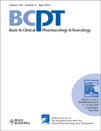Impact of Concentrative Nucleoside Transporter 1 Gene Polymorphism on Oral Bioavailability of Mizoribine in Stable Kidney Transplant Recipients
Abstract
Abstract: Mizoribine, an immunosuppressive anti-metabolite, is largely excreted into urine in its unchanged form, and its pharmacokinetics has been considered to be dependent on the glomerular filtration rate. However, the pharmacokinetic disposition of mizoribine has not been fully clarified. The aim of this study was to evaluate the pharmacokinetic disposition of mizoribine based on polymorphism of concentrative nucleoside transporter (CNT) 1 gene in kidney transplant recipients. Thirty-four Japanese stable recipients receiving an immunosuppressive regimen containing mizoribine for more than four months after transplantation were enrolled. Each recipient had been receiving a fixed dose of mizoribine for at least one month before enrolment. Oral bioavailability of mizoribine was obtained by dividing its amount in 24-hr urine by the daily dose. The median and interquartile range of the dose-normalized plasma concentration of mizoribine at 12 hr (C12) were 6.11 and 3.47–10.9 ng/ml per mg, respectively. The median bioavailability of mizoribine was 44.8%, and interindividual variability was also observed (interquartile range, 37.8–61.5%). The correlation coefficient between creatinine clearance and substitute renal clearance (CLMZ) estimated from the mizoribine C12 was 0.65. The CNT1 G565A allele frequency was 51.5%. The mizoribine bioavailability was significantly lower in 565GA and AA than that in GG (median, 42.0%, 41.4% and 62.4%, respectively). No significant differences were observed in the dose-normalized C12 of mizoribine and substitute CLMZ between the G565A genotypes. The mizoribine bioavailability was affected by CNT1 G565A in kidney transplant recipients. CNT1 G565A would contribute to interindividual differences in plasma disposition of mizoribine.




